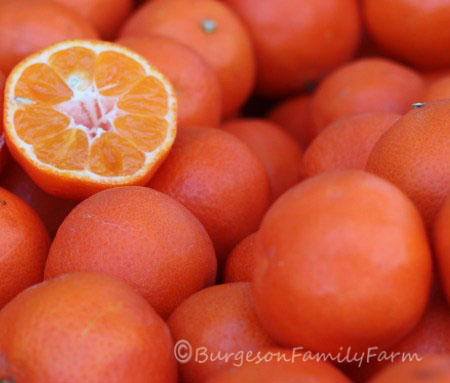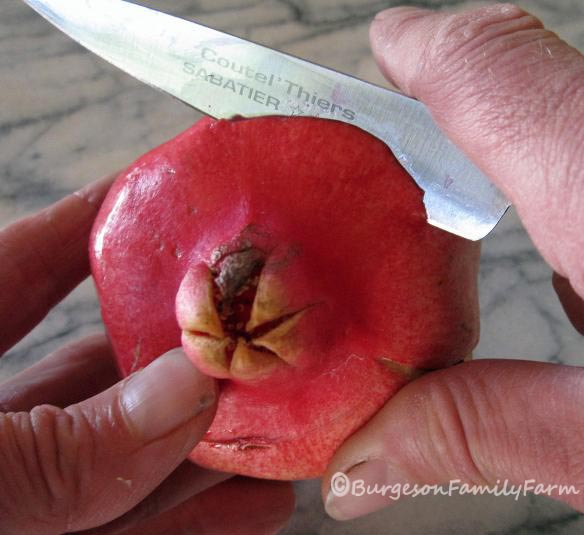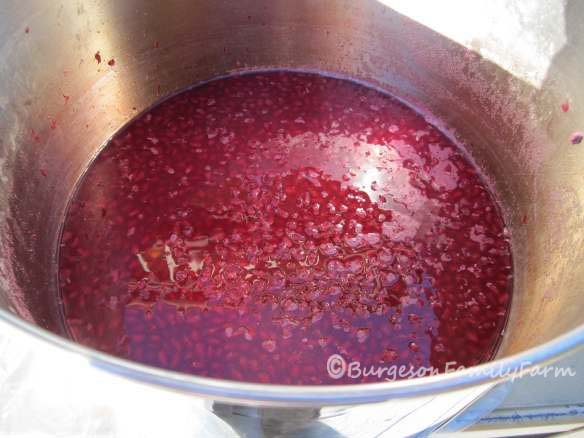
On Burgeson Family Farm, our Satsuma mandarins are our primary crop, but we have planted a variety of specialty citrus and other fruit on our two acres in Newcastle, California.
Big changes are coming to our farm over the next few weeks, so stay tuned. In the meantime, I am taking a trip down memory lane by sharing these photos of some of the fun things we have grown on this fertile piece of the planet over the years.
About 10 years ago we started planting avocados. We are growing the Mexicola, Stewart and Pinkerton avocados and are having some great results with these more frost tolerant varieties.
The white powder on the tree is called Kaolin Clay. It is a fine organic clay powder we mix with water and spray on some of our trees such as apples and avocados. It protects the fruit and leaves from sunburn and also discourages insects. It washes off the fruit after we harvest.

Mexicola Avocado.
Mexicola avocados have a very thin skin and buttery flesh. The skin is actually edible!

During harvest season we often will host and open house where we offer citrus tastings.
If you have never tried some of these specialty citrus fruits, seek them out when they are in season and have a taste.
We are famous for our sweet, seedless, easy to peel Satsuma mandarins.
Satsuma Mandarins
Have you ever tasted Algerian clementines? They are incredibly sweet. They do have seeds, unlike our Satsumas.

Algerian Clementines
Our first citrus crop in the fall is usually the Persian (Bearss) Limes. They have no seeds and have more juice than most store bought limes. They start out green and eventually turn yellow but can be used when they are yellow or green. The yellow ones are more juicy and sweet, the green ones are more tart and aromatic.

Persian (Bearss) limes
Key limes are small, and have seeds, and are more tart than the Persian limes. Most importantly they are grown right here on our farm, not imported from Mexico. We use no pesticides or herbicides in growing any of our produce. Key limes can be used in any recipe calling for limes. We use them in cocktails.

California Key Limes
Oro Blanco grapefruit are like a Pomelo, with very thick skin and sweet, juicy flesh. We peel them and eat them like an orange, and will often remove the membrane from each segment as it is so easy to remove. When you eat a peeled Oro Blanco segment, you will agree it is the sweetest grapefruit you have ever tasted. Because they are so juicy, they are fabulous for fresh squeezed grapefruit juice and have a very high yield. Of course you can also cut them in half and eat them with a grapefruit spoon but expect them to have more juice than a typical grapefruit.
 Oro Blanco Grapefruit
Oro Blanco Grapefruit
Sanguinella blood oranges have a sweet tart flavor, with a hint of raspberry. They are popular for using in savory dishes and salad, they make beautiful juice for cocktails and delicious marmalade. Blood oranges are also fun to eat sliced in wedges. Try tucking some wedges in a child’s lunchbox for fun. Kids love the name and the color!
 Sanguinella Blood Orange
Sanguinella Blood Orange

We also grow Tarocco blood oranges.These are interesting in that they color up and sweeten in storage after harvest so we usually keep them for several weeks after harvest before selling or eating them.
Cara Cara oranges have pink flesh and otherwise are similar to a Navel orange.

Cara Cara Orange
Washington Navel and Valencia oranges are your more common varieties, and they seem to be especially sweet when grown on our Sierra foothills property. Washington Navels are eaten as a fresh orange. The juice will turn bitter soon after pressing. Valencia oranges can be used as fresh fruit or for juice as they are the traditional Florida juice orange.

Valencia orange
Meyer Lemons are the most frost tolerant of all lemons. They are very sweet, aromatic, and juicy, with soft skins, and as the season progresses they get bigger, with thicker skin. Meyer Lemons are actually a cross between a mandarin and a lemon

Meyer Lemon
Our Meyer Lemon tree typically gets between 500 and 1000 pounds of fruit per year!
We have 2 types of apple trees, Granny Smith and Winesap. The Granny Smith apples get very sweet and delicious if you leave them on the tree until late fall. Winesap apples develop more flavor and sweetness when you store them for a week or two after you harvest them.

Winesap apples
Adrian has planted a lot of pomegranate trees over the years.
 We especially like the special Parfianka variety shown below. They have softer seeds than the “Wonderful” pomegranate you typically see in the stores and the seeds are easier to remove from the skins.
We especially like the special Parfianka variety shown below. They have softer seeds than the “Wonderful” pomegranate you typically see in the stores and the seeds are easier to remove from the skins.

Parfianka Pomegranates
We love to make juice from pomegranates by removing the seeds, then pressing them with this little tabletop press.

We grow a large crop of garlic every year, then set some aside to plant for the following year. Some varieties last longer after harvest, giving us home grown garlic year round.

There are several types of garlic shown here. The big red ones are Spanish Roja. They grow very large in our well drained soil.
Winter squash is another crop that can be grown over the summer and stored to be eaten for much of the winter.

Butternut Squash
We have found that Sweetmeat squash, which are larger, last a bit longer in storage than the Butternut.
Quince are an old fashioned winter fruit. We have one dwarf tree and it is prolific.

Smyrna Quince
Quince must be cooked to be eaten and will turn a lovely pink color as they cook.
Fall is olive harvest season.
 .
.
We typically use some of the olives for preserving and the majority of them to make oil which we use throughout the year.
Fuyu persimmons are also harvested In the fall.

Fuyu Persimmon
Fuyu Persimmons can be eaten when crispy, like an apple, or when soft. Unlike Hachiya persimmons, they are never bitter.
In the summer we usually plant a vegetable garden. We especially have success with tomatoes, peppers, cucumbers and squash.

Tomatoes are great to can, freeze or dry for the winter so a big crop is no problem.
Figs are another great summer crop and some of the heirloom varieties we are growing are giant!


Black Mission Figs
We like to dry the figs to eat for snacks during the winter.
We are not animal farmers, but when our son was young we did have chickens. He loved to play with them

This is the time of year when all of these trees start blooming in preparation for another harvest season on the farm. The farm is abuzz with the humming of thousands of bees at work.


The scent of so many citrus trees in bloom is intoxicating!
Before we know it, we will have made another trip around the sun, and the trees will be loaded and waiting for harvest once again.

Thanks for visiting. We hope you enjoyed this little tour of Burgeson Family Farm
© 2021 Dayna Green-Burgeson RD, CDE. All Rights Reserved.
Reproduction of any content in the article without the written permission of the author is prohibited.






















 That fruit then dropped to the ground, causing significant loss of our crop for the year.
That fruit then dropped to the ground, causing significant loss of our crop for the year.
 A large Meyer Lemon
A large Meyer Lemon
















